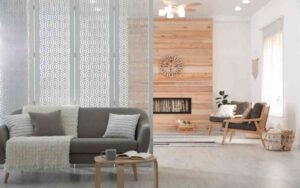Hearing your neighbours walking around, TV, doors constantly banging, flushing toilets or even conversations through adjoining walls is an annoyance. It may drive you to distraction and cause unnecessary strife between you and your neighbours.
However, before you get cross at them, you may want to take a look at your building code, especially if it is a new build. If this is a new build, you are within your rights to ask your builder to bring the sound insulation up to standard.
When buying a new home people often don’t think about asking what the acoustic performance of the walls and floors is like. It may be worth talking to someone who is part of the residents association or the management company from the builder’s previous schemes. This way you will get ‘real’ information and not just figures that won’t mean much.
According to Mike from soundproofing company NoiseStop Systems “All homes are unfortunately not created equally.” Although building regulations since 2003 brought about the introduction of improved sound regulations on domestic dwellings, they still do not go far enough. Add to that the new design trends of open plan living, high ceilings, hard floors and lots of windows, and you are left with a potent mix of noise creating opportunities.
This is what the Building Regulations, updated 2010, version states regarding the Resistance to the passage of sound:
Protection against sound form other parts of the building and adjoining buildings
E1 – Dwelling-houses, flats and rooms for residential purposes shall be designed and constructed in such a way that thy provide reasonable resistance to sound from other parts of the same building and from adjoining buildings.
E2 – Dwelling-houses, flats and rooms for residential purposes shall be designed and constructed in such a way that:
- internal walls between a bedroom or a room containing a water closet and other rooms; and
- Internal floors
Provide reasonable resistance to sound.
Requirement E2 does not apply to:
- an internal wall which contains a door.
- An internal wall which separates an en suite toilet from the associated bedroom
- Existing walls and floors in a building which is subject to a material change of use
So why is this not helping?
Although part E1 has proved to be successful in reducing the number of noise complaints between neighbours, this only came into effect from houses built from 2003 onwards. Previous builds were not brought up to these standards and may therefore just simply not have enough sound insulation between properties.
However, the E2 protection levels were limited to a requirement for 40dB (decibels) of sound reduction with internal walls and floors and this is not particularly effective. Also, masonry walls or concrete floors will meet these requirements, but timber or steel walls and floors only require the addition of some insulation and a slightly thicker plasterboard to be used. Plus, as you can see above, there is no soundproofing required around en suite bathrooms or walls that have door.
Add to that the building checks that are carried out and there isn’t much thought or effort going into creating sound protections between properties or in apartment buildings.
New homes are meant to be sold with an acoustic rating from A to E. These ratings will let the consumer know how buffered the sound will be between them and their neighbours.
Unfortunately the minimum standards for sound insulation are not always being enforced either. With the speed at which some new builds are erected these days, it is no wonder that sometimes this is something that some builders will skip over, and some smaller builders may not even be aware of the new regulations despite them being introduced fully in 2010.
Although a property may fail its acoustic test, it won’t necessarily fail to comply with building regulations. All it takes is for a small gap to be left in the wall and the sound insulation will be dramatically affected.
Plus certain design trends as mentioned above really can create poor acoustics within a house.
What can you do about it?
If you have problems with noise pollution between floors, adjoining walls or from pipes within the property, don’t despair. There are many simple solutions that can help, from acoustic boards to acoustic underlay and more. The first course of action would be to speak to your builders if you are in a new build.
The important thing is to be realistic about your expectations and know that you aren’t going to have a totally silent living situation. But, you can reduce the noise in your home with a few simple tweaks, even strategically adding soft furnishing.
For people in older builds, or who have exhausted the options they have with the builders, then you can speak to sound proofing professionals to get advice.
Call one of our experts to discuss what is the best solution for you. We can help you your specific noise concerns. We are here to help make your life more peaceful.




